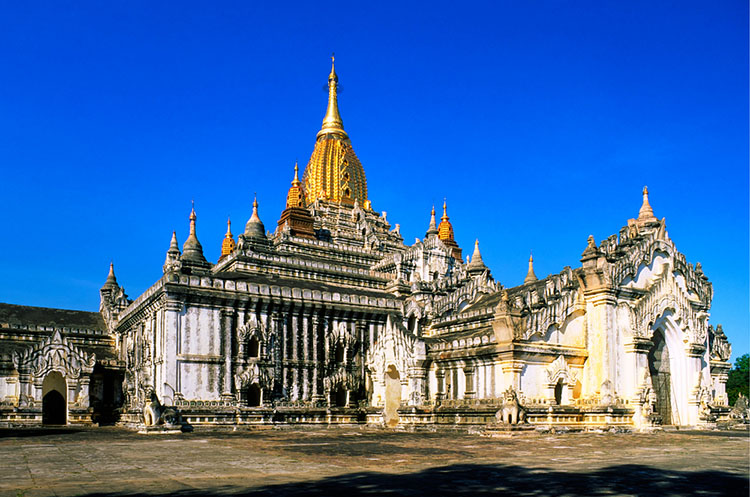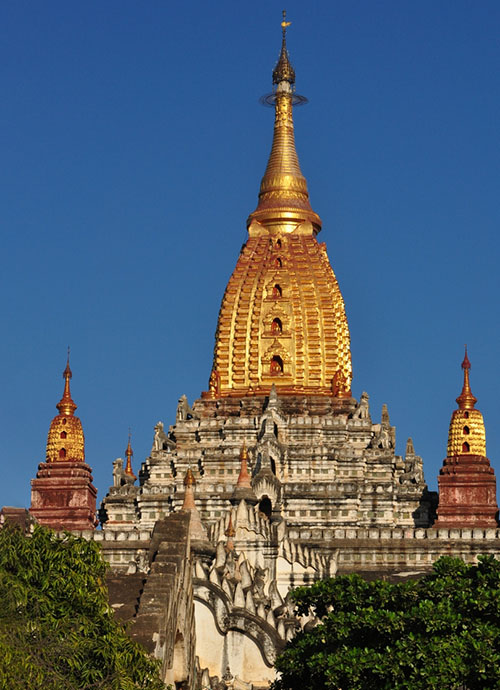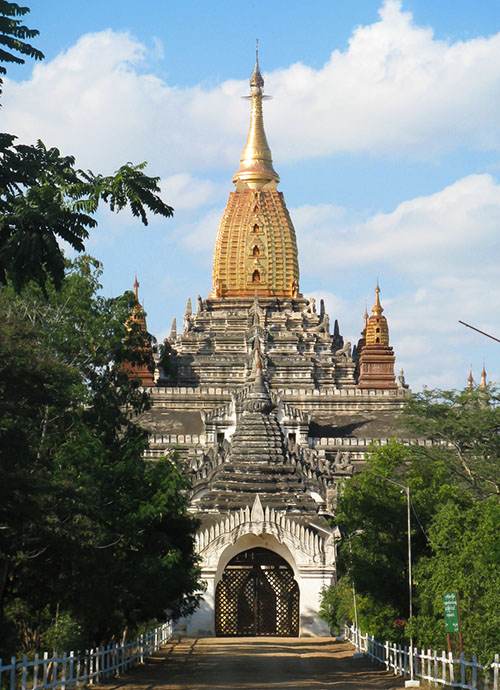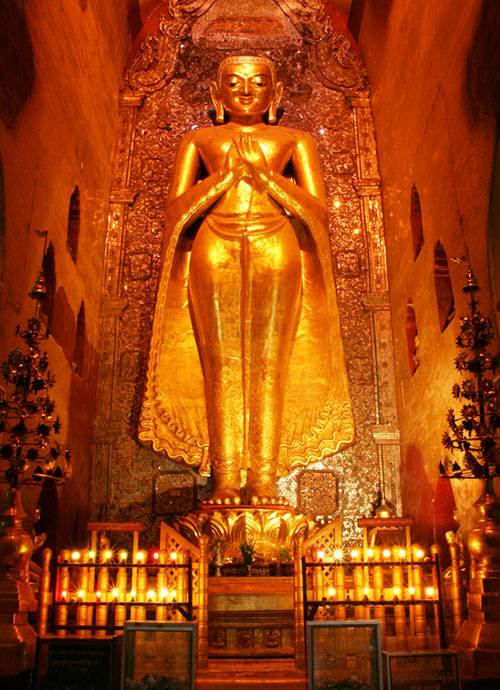
Ananda pagoda
One of Bagan’s most beautiful temples
Mon & North Indian influence
Single storey structure
The Ananda temple is one of Bagan’s best known and most beautiful temples. It was one of the first great temples to be build in Bagan and is well preserved. The temple is found near the Tharabar gate, the only gate remaining of the original 12 in the old Bagan city walls.
The Ananda pagoda, also named Ananda pahto and Ananda phaya is a single storey structure built towards the end of the early Bagan period. The architectural style shows Mon and North Indian influence.
Gilded shikhara
The temple’s most distinctive feature is the gilded shikhara, the tower like spire on top of the pagoda. The reflection of the gilded shikhara is visible from miles away over the Bagan plains. After dark the Ananda pagoda is lit up by spotlights creating a mystical atmosphere.
The Ananda was damaged during the 1975 earthquake, and has been extensively restored since then.

Legend of the Ananda temple
A local legend tells the story of the founding of the Ananda temple. Towards the end of the 11th century eight monks from India visited Bagan. They were granted an audience by King Kyanzittha.
The monks told the King about a legendary cave temple in the Himalaya mountains and created a vision for the King to see the temple and the snowy landscape. The story and vision left the King very impressed and he decided to replicate the temple in Bagan. It is said that after the Ananda temple was completed, the King had the architects executed, to make sure anything like it could never be build again.

Architecture of the Ananda
The Ananda is an elegant, symmetrical structure with the layout of a Greek cross. One of the most noticeable and beautiful features is the gilded top called shikhara, that is placed on the center of the building. This tower like structure originates from North India and shows Indian influence in the architectural style of the Ananda.
The shikhara contains five niches on all sides placed over each other, each niche containing a Buddha image. On top of that is a hti, a spire ornament in the shape of an umbrella. The shikhara and hti were gilded in 1990 to mark the start of Ananda’s construction 9 centuries earlier. Total height of the structure including the hti is about 51 meters.
Chinthes guarding receding terraces
On top of the square central block are six receding terraces. Each corner of the second terrace contains a smaller golden shikhara. The terraces contain numerous Chinthes, the mythological Burmese lions that guard Buddhist temples all across Burma.
In the center of the whitewashed structure is a square room containing four large standing Buddha images. A corridor runs around the central room, the walls of which contain 3 rows of niches that enshrine Buddha images in different poses. About 80 large sandstone reliefs show scenes from the life of the Gautama Buddha some 2,500 years ago.
On the grounds of the Ananda temple is a monastery building named Ananda Oak Kyaung or Ananda brick monastery. The small monastery was built in 1137, its walls contain 18th century murals depicting scenes from the life of the Buddha. The temple grounds are surrounded by a high wall, in which four large gates topped with a stupa provide access to the grounds.
The four 9½ meter tall standing Buddha images
In the center of the Ananda pagoda is a large square room where four magnificent standing Buddha images are placed in arched recesses. The teak wooden 9½ meters tall gilded images represent the four previous Buddhas that have reached nirvana, namely Kassapa Buddha (South), Kakusandha Buddha (North), Konagamana Buddha (East) and Gautama Buddha (West).
The Kakusandha Buddha image and the Kassapa Buddha image date back the the early 12th century when the Ananda was built. They are in the Dhammachakka Mudra, a gesture that represents the setting in motion of the Wheel of Dhamma, the teachings of the Buddha. The Konagamana image and the Gautama image are in the Mandalay style and were likely made in the 17th century after the originals were destroyed by a fire.
The Gautama Buddha, the most recent Buddha who lived 2,500 years ago is in the Abhaya Mudra, which expresses fearlessness. The Konagamana Buddha holds a small object in his right hand which looks like a pill. This Mudra might represent the teachings of the Buddha as a medicine against human suffering.
The expression on the face of the Kassapa image appears to change when viewed from different distances. While there appears to be a smile on the image’s face from nearby, from further away the smile seems to fade.
The walls in the central chamber have been whitewashed; some of the murals that were originally there have been restored. In front of the Gautama image are two lacquer statues. One is of King Kyanzittha, the builder of the Ananda in a devout position of paying respect to the Buddha. The other one is of Shin Arahan, the monk from the Thaton Kingdom who converted King Anawrahta to Buddhism.

Jataka tales plaques
The base and six receding terraces of the Ananda pagoda contain the largest collection of plaques of all Bagan temples. The plaques are glazed terracotta tiles with depictions of tales from the Jataka stories, the tales about the previous lives of the Buddha. One side of the base of the Ananda contains 553 plaques that show the Mara, a demon who tries to prevent the Buddha from reaching enlightenment. The other side contains depictions of the Gods who celebrate the defeat of Mara and his army.
The terraces contain plaques that each show a different scene from a particular Jataka tale. The first three terraces contain 537 plaques with a description in ancient Pali language. The upper terraces contain another set of 375 plaques with a description in Mon language.
Getting to the pagoda
Other temples in Bagan
Among the other temples & pagodas in Bagan are:
- Shwezigon pagoda
- Gawdawpalin temple
- Sulamani temple
- Thatbyinnyu temple
- Seinnyet sister temples
- Bupaya pagoda
- Mahabodhi temple
- Htilominlo temple
- Mingalazedi pagoda
- Dhammayazika pagoda
- Dhammayangyi temple
- Lawkananda pagoda
- Manuha temple
- Pyathadar temple
- Pahtothamya temple
- Myazedi pagoda
- Shwesandaw pagoda
- Gubyaukgyi temple
History
How to get to Bagan and how to get around
- Shwezigon pagoda
- Ananda pagoda
- Gawdawpalin temple
- Sulamani temple
- Thatbyinnyu temple
- Seinnyet sister temples
- Bupaya pagoda
- Mahabodhi temple
- Htilominlo temple
- Mingalazedi pagoda
- Dhammayazika pagoda
- Dhammayangyi temple
- Lawkananda pagoda
- Manuha temple
- Pyathadar temple
- Pahtothamya temple
- Myazedi pagoda
- Shwesandaw pagoda
- Gubyaukgyi temple